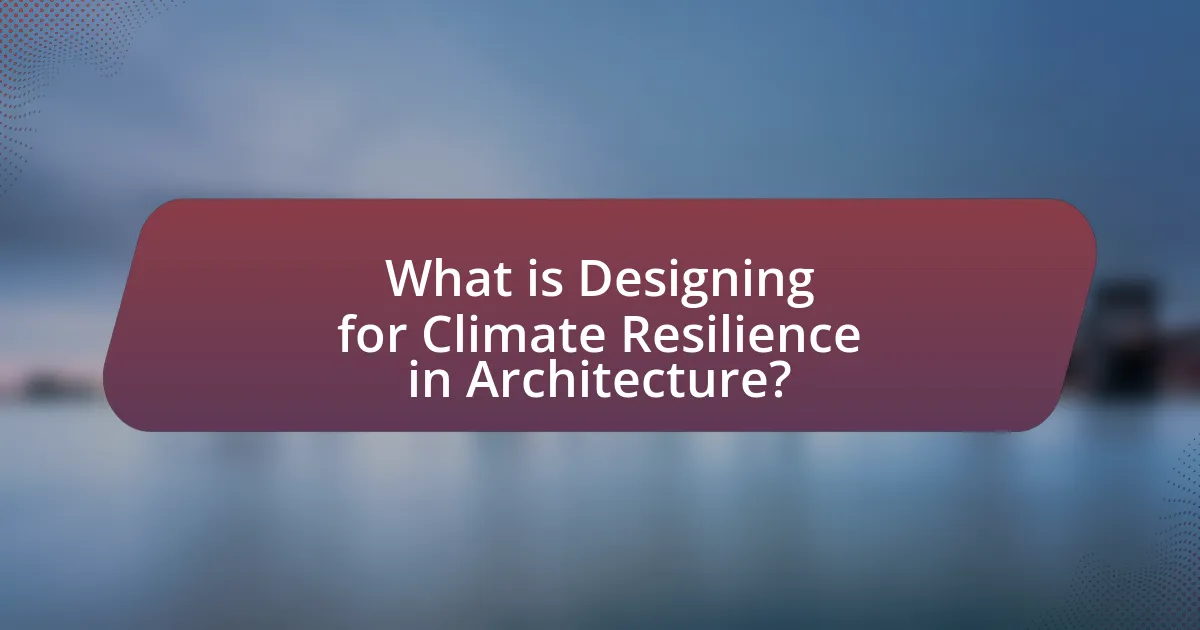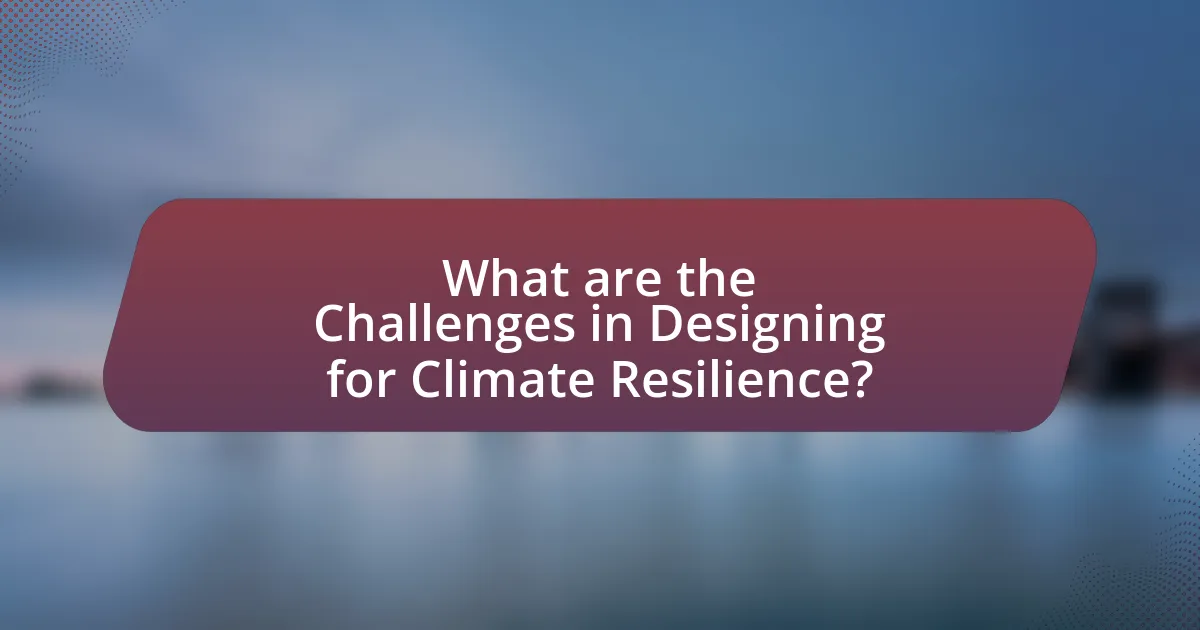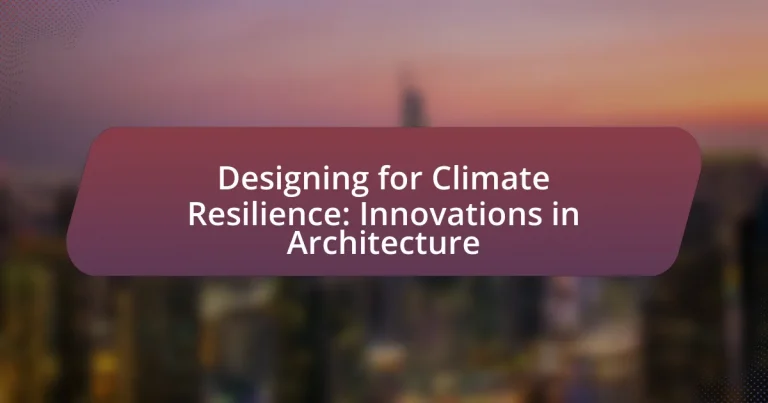Designing for climate resilience in architecture focuses on creating structures that can withstand and adapt to the impacts of climate change, such as extreme weather events and rising sea levels. The article outlines key principles of climate-resilient architecture, including adaptability, sustainability, and resource efficiency, while highlighting the importance of integrating innovative materials and technologies. It discusses the influence of environmental factors on design decisions, the economic benefits of resilient buildings, and the challenges architects face in implementing these designs. Additionally, the article emphasizes the role of community engagement and collaboration in developing effective climate-resilient solutions.

What is Designing for Climate Resilience in Architecture?
Designing for climate resilience in architecture involves creating buildings and spaces that can withstand and adapt to the impacts of climate change, such as extreme weather events, rising sea levels, and temperature fluctuations. This approach integrates sustainable practices, such as using durable materials, optimizing energy efficiency, and incorporating green infrastructure, to enhance the longevity and functionality of structures. Research indicates that resilient design can significantly reduce damage costs and improve recovery times after climate-related disasters, highlighting its importance in contemporary architectural practices.
How does climate resilience influence architectural design?
Climate resilience significantly influences architectural design by prioritizing sustainability and adaptability to environmental changes. Architects incorporate materials and techniques that withstand extreme weather events, such as flooding and heatwaves, thereby enhancing the longevity and safety of structures. For instance, the use of elevated foundations in flood-prone areas and green roofs for temperature regulation exemplifies this approach. Research indicates that buildings designed with climate resilience in mind can reduce energy consumption by up to 30% and lower maintenance costs over time, demonstrating the economic benefits alongside environmental considerations.
What are the key principles of climate-resilient architecture?
The key principles of climate-resilient architecture include adaptability, sustainability, and resource efficiency. Adaptability ensures that buildings can withstand and respond to changing climate conditions, such as extreme weather events. Sustainability focuses on using materials and practices that minimize environmental impact, promoting long-term ecological balance. Resource efficiency emphasizes the optimal use of energy and water, reducing waste and enhancing the building’s overall performance. These principles are supported by research indicating that climate-resilient designs can significantly reduce vulnerability to climate change impacts, as evidenced by case studies in regions prone to flooding and heatwaves.
How do environmental factors shape design decisions?
Environmental factors significantly influence design decisions by dictating the materials, orientation, and energy efficiency of structures. For instance, architects consider local climate conditions, such as temperature, humidity, and wind patterns, to optimize building performance and sustainability. Research indicates that buildings designed with climate resilience in mind can reduce energy consumption by up to 30%, as seen in the U.S. Green Building Council’s studies on LEED-certified projects. Additionally, environmental factors like site topography and vegetation inform decisions on drainage and landscaping, which are crucial for mitigating flood risks and enhancing biodiversity.
Why is climate resilience important in modern architecture?
Climate resilience is crucial in modern architecture because it ensures that buildings can withstand and adapt to the impacts of climate change, such as extreme weather events and rising sea levels. As reported by the Intergovernmental Panel on Climate Change, climate-related disasters have increased significantly, leading to substantial economic losses and threats to human safety. By integrating climate resilience into architectural design, structures can minimize damage, reduce repair costs, and enhance the safety and well-being of occupants. This approach not only protects investments but also contributes to sustainable urban development, as resilient buildings can maintain functionality during adverse conditions, thereby supporting community stability and continuity.
What are the risks associated with climate change for buildings?
Climate change poses several risks for buildings, including increased flooding, extreme temperatures, and severe weather events. These risks can lead to structural damage, higher maintenance costs, and reduced lifespan of building materials. For instance, the National Oceanic and Atmospheric Administration (NOAA) reports that rising sea levels and increased precipitation can result in more frequent flooding, which compromises the integrity of foundations and basements. Additionally, higher temperatures can cause materials to expand and contract, leading to cracks and other forms of deterioration. Furthermore, severe weather events, such as hurricanes and tornadoes, can cause catastrophic damage, necessitating costly repairs and retrofitting.
How can resilient design mitigate these risks?
Resilient design can mitigate risks associated with climate change by incorporating adaptive strategies that enhance the durability and functionality of structures. This approach includes using materials that withstand extreme weather, designing for natural ventilation to reduce energy consumption, and implementing water management systems to prevent flooding. For instance, buildings designed with elevated foundations can reduce flood damage, while green roofs can manage stormwater and improve insulation. Evidence from the American Institute of Architects indicates that resilient design not only protects property but also reduces long-term costs associated with repairs and energy use, demonstrating its effectiveness in risk mitigation.

What are the Innovations in Climate-Resilient Architecture?
Innovations in climate-resilient architecture include the use of sustainable materials, adaptive building designs, and advanced technologies for energy efficiency. Sustainable materials, such as bamboo and recycled steel, reduce environmental impact while enhancing durability. Adaptive designs, like elevated structures and green roofs, mitigate flooding and heat effects. Technologies such as smart sensors and energy-efficient systems optimize resource use and improve building performance. These innovations are supported by research indicating that climate-resilient architecture can significantly reduce vulnerability to climate change impacts, as highlighted in the 2021 report by the Intergovernmental Panel on Climate Change.
How are new materials contributing to climate resilience?
New materials are enhancing climate resilience by providing improved durability, energy efficiency, and adaptability to environmental changes. For instance, materials like self-healing concrete can repair cracks autonomously, extending the lifespan of structures and reducing maintenance costs. Additionally, advanced insulation materials, such as aerogels, significantly decrease energy consumption for heating and cooling, thereby lowering greenhouse gas emissions. Research indicates that using sustainable materials, like bamboo and recycled plastics, can also minimize resource depletion and waste, contributing to a more sustainable built environment. These innovations collectively support the construction of buildings that can withstand extreme weather events and adapt to shifting climate conditions, thereby reinforcing overall climate resilience.
What types of sustainable materials are being used?
Sustainable materials commonly used in architecture include bamboo, recycled steel, reclaimed wood, and hempcrete. Bamboo is favored for its rapid growth and strength, making it an eco-friendly alternative to traditional timber. Recycled steel reduces the need for new metal production, thereby lowering carbon emissions. Reclaimed wood repurposes existing materials, minimizing waste and preserving forests. Hempcrete, made from hemp fibers, offers excellent insulation properties and is carbon-negative, contributing to lower overall environmental impact. These materials collectively support climate resilience by reducing resource consumption and promoting sustainable building practices.
How do these materials enhance building performance?
These materials enhance building performance by improving energy efficiency, durability, and environmental sustainability. For instance, advanced insulation materials reduce heat loss, leading to lower energy consumption for heating and cooling, which can decrease energy costs by up to 30% according to the U.S. Department of Energy. Additionally, materials such as high-performance glazing and reflective roofing can minimize heat absorption, further enhancing thermal comfort and reducing reliance on HVAC systems. Furthermore, sustainable materials like recycled steel and bamboo contribute to lower carbon footprints and promote resource conservation, aligning with climate resilience goals in architecture.
What technological advancements are shaping climate-resilient design?
Technological advancements shaping climate-resilient design include the use of advanced materials, smart building technologies, and data analytics. Advanced materials such as self-healing concrete and energy-efficient insulation enhance durability and reduce energy consumption, contributing to resilience against climate impacts. Smart building technologies, including IoT sensors and automated systems, optimize energy use and monitor environmental conditions, allowing for adaptive responses to climate variability. Data analytics, particularly through climate modeling and predictive analytics, inform design decisions by assessing risks and optimizing resource allocation. These advancements collectively enable architects and engineers to create structures that withstand extreme weather events and adapt to changing climate conditions.
How is smart technology integrated into resilient architecture?
Smart technology is integrated into resilient architecture through the use of advanced sensors, data analytics, and automation systems that enhance building performance and adaptability to environmental changes. These technologies enable real-time monitoring of structural integrity, energy consumption, and environmental conditions, allowing for proactive responses to potential hazards such as extreme weather events. For instance, smart building systems can adjust heating, cooling, and lighting based on occupancy and weather forecasts, thereby optimizing energy use and reducing vulnerability to climate impacts. Studies have shown that buildings equipped with smart technology can achieve up to 30% energy savings and significantly improve occupant safety during emergencies, demonstrating the effectiveness of these integrations in promoting resilience.
What role does data play in designing for climate resilience?
Data plays a crucial role in designing for climate resilience by providing the necessary insights to understand environmental risks and inform decision-making. It enables architects and planners to analyze climate patterns, assess vulnerabilities, and predict future scenarios, which are essential for creating structures that can withstand extreme weather events. For instance, data from climate models can reveal trends in temperature and precipitation, allowing for the design of buildings that are better insulated and equipped to handle flooding or heatwaves. Additionally, geographic information systems (GIS) can map areas at risk of natural disasters, guiding the placement and construction of infrastructure in safer locations. This reliance on data-driven approaches is supported by studies showing that communities utilizing comprehensive climate data in their planning processes experience reduced damage and recovery costs during climate-related events.

What are the Challenges in Designing for Climate Resilience?
The challenges in designing for climate resilience include the need to integrate adaptive strategies, manage uncertainty, and address socio-economic disparities. Adaptive strategies require architects to anticipate future climate scenarios, which can be complex due to the unpredictability of climate change. Managing uncertainty involves creating designs that can withstand extreme weather events, necessitating robust materials and construction techniques. Additionally, socio-economic disparities can hinder equitable access to resilient infrastructure, as marginalized communities often lack resources for adaptation. These challenges highlight the necessity for interdisciplinary collaboration and innovative solutions in architectural practices to effectively address climate resilience.
What obstacles do architects face in implementing resilient designs?
Architects face several obstacles in implementing resilient designs, including financial constraints, regulatory challenges, and a lack of standardized practices. Financial constraints often limit the ability to invest in advanced materials and technologies that enhance resilience. Regulatory challenges arise from building codes and zoning laws that may not prioritize or accommodate innovative resilient design strategies. Additionally, the absence of standardized practices can lead to inconsistencies in design approaches, making it difficult for architects to effectively implement resilience measures across different projects. These factors collectively hinder the widespread adoption of resilient architectural designs.
How do regulatory frameworks impact climate-resilient architecture?
Regulatory frameworks significantly influence climate-resilient architecture by establishing standards and guidelines that promote sustainable building practices. These frameworks often mandate the incorporation of energy-efficient materials, renewable energy sources, and adaptive design strategies that mitigate climate risks. For instance, building codes may require structures to withstand extreme weather events, thereby enhancing their resilience. Additionally, regulations can incentivize developers to adopt green technologies through tax breaks or grants, further encouraging the integration of climate resilience into architectural designs. Such frameworks are essential for ensuring that new constructions not only meet current environmental challenges but also anticipate future climate scenarios, thereby fostering long-term sustainability in urban development.
What are the financial considerations for resilient building projects?
Financial considerations for resilient building projects include initial investment costs, long-term operational savings, and potential funding sources. The initial investment often involves higher upfront costs due to advanced materials and technologies designed to withstand climate impacts. However, these projects can lead to significant long-term savings through reduced maintenance and repair costs, as well as lower insurance premiums due to decreased risk of damage. Additionally, various funding sources, such as government grants, tax incentives, and private investments, can support these projects, making them more financially viable. For instance, the Federal Emergency Management Agency (FEMA) offers grants for projects that enhance community resilience, which can offset some of the initial costs.
How can architects overcome these challenges?
Architects can overcome challenges in designing for climate resilience by integrating sustainable materials, employing advanced technologies, and utilizing adaptive design strategies. Sustainable materials, such as recycled or locally sourced products, reduce environmental impact and enhance durability. Advanced technologies, including Building Information Modeling (BIM) and energy simulation tools, allow architects to optimize designs for energy efficiency and climate adaptability. Adaptive design strategies, such as elevating structures in flood-prone areas or incorporating green roofs, help mitigate risks associated with climate change. These approaches are supported by research indicating that buildings designed with resilience in mind can significantly reduce energy consumption and improve occupant safety.
What strategies can be employed to advocate for resilient design?
To advocate for resilient design, stakeholders can employ strategies such as promoting community engagement, integrating sustainability education, and leveraging policy frameworks. Community engagement fosters local participation in design processes, ensuring that solutions reflect the needs and values of residents, which is essential for long-term resilience. Integrating sustainability education into curricula raises awareness about climate impacts and the importance of resilient design among future architects and builders. Additionally, leveraging policy frameworks, such as building codes and zoning regulations that prioritize resilience, can create a supportive environment for implementing innovative architectural solutions. These strategies collectively enhance the adoption of resilient design practices in architecture.
How can collaboration enhance climate resilience in architecture?
Collaboration can enhance climate resilience in architecture by integrating diverse expertise and perspectives, leading to more innovative and effective design solutions. When architects, engineers, urban planners, and environmental scientists work together, they can address complex climate challenges more comprehensively. For instance, a study by the American Institute of Architects found that collaborative design processes result in buildings that are 20% more energy-efficient and better equipped to withstand extreme weather events. This collective approach fosters the sharing of best practices and technologies, ultimately creating structures that are not only sustainable but also adaptable to changing climate conditions.
What are the best practices for designing climate-resilient buildings?
The best practices for designing climate-resilient buildings include incorporating sustainable materials, optimizing energy efficiency, and implementing adaptive design strategies. Sustainable materials, such as recycled or locally sourced products, reduce environmental impact and enhance durability. Energy efficiency can be achieved through passive solar design, high-performance insulation, and energy-efficient systems, which lower energy consumption and greenhouse gas emissions. Adaptive design strategies, such as elevating structures in flood-prone areas and using flexible layouts, allow buildings to withstand extreme weather events. These practices are supported by research indicating that climate-resilient buildings can significantly reduce damage costs and improve community resilience in the face of climate change.
How can architects incorporate community input into resilient designs?
Architects can incorporate community input into resilient designs by actively engaging local residents through workshops, surveys, and collaborative design sessions. This participatory approach ensures that the designs reflect the needs, values, and experiences of the community, leading to more effective and accepted solutions. Research shows that projects involving community participation, such as the “Community-Based Participatory Research” model, result in designs that are better suited to local conditions and enhance social cohesion. By integrating feedback from community members, architects can create spaces that not only withstand climate challenges but also foster a sense of ownership and pride among residents.
What lessons can be learned from successful climate-resilient projects?
Successful climate-resilient projects demonstrate the importance of integrating local knowledge and community engagement in the design process. These projects often involve stakeholders in decision-making, ensuring that solutions are culturally relevant and tailored to specific environmental challenges. For instance, the successful implementation of the “Green Roofs” initiative in Chicago has shown that involving local communities leads to increased awareness and participation in sustainability efforts, resulting in improved urban biodiversity and reduced heat island effects. Additionally, these projects highlight the necessity of adaptive design strategies that can evolve with changing climate conditions, as seen in the Netherlands’ flood management systems, which incorporate flexible infrastructure to respond to rising sea levels.





